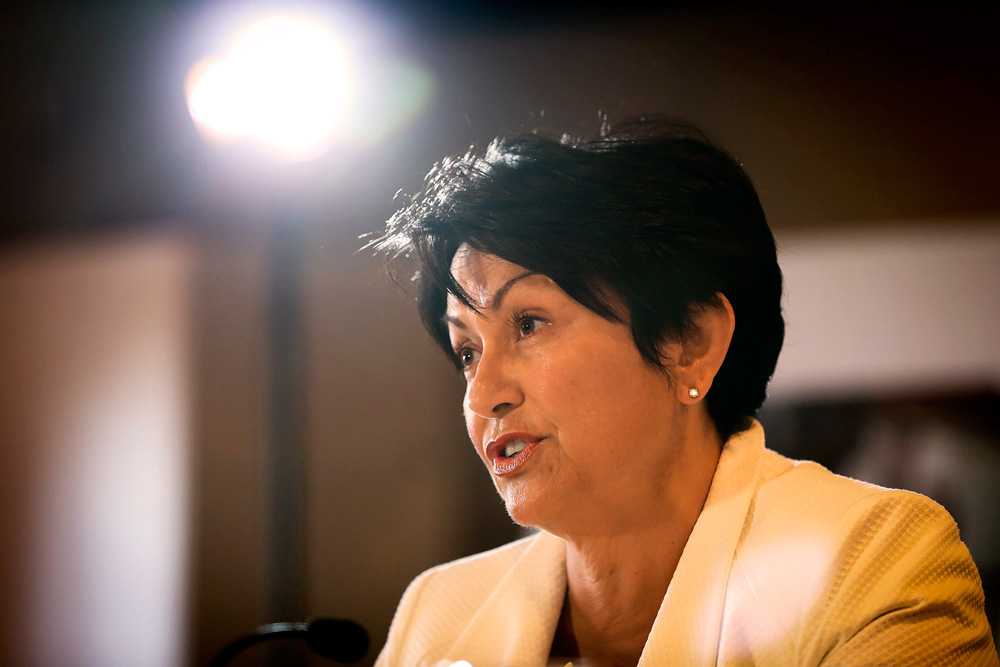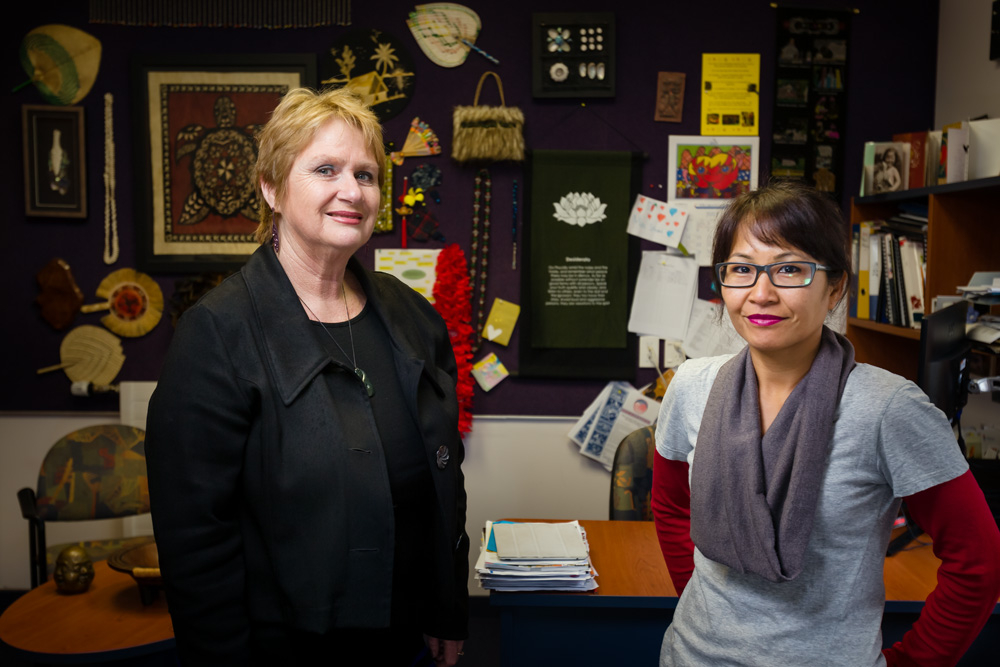Mar 12, 2015 Schools
This story first appeared in the October 2014 issue of North & South.
On a drizzly Wednesday night in early August, the Ponsonby Primary School hall was packed with teachers, parents, and interested others, brought together under the banner of the Tick for Kids campaign. National’s flagship education policies – National Standards and charter schools – were under attack. And somehow the Minister of Education, Hekia Parata, managed to keep smiling.
In his opening address, Associate Professor Peter O’Connor echoed the optimistic conclusions of Nigel Latta’s documentary School Report: What’s Going On, which had screened the night before. “There isn’t a crisis in education,” said O’Connor, who’s based at the School of Critical Studies in Education at Auckland University. “And those who would create one for their own political or ideological ends need to look hard at their motivations and the evidence.”
He then introduced the elephant in the room: poverty. “There are children only 10 kilometres from here who went to school today without anything on their feet, no food in their stomachs, and from cold homes. As the rain fell about three o’clock, many would have realised their walk home would mean the clothes they go to school in tomorrow will still be wet.”
That invisible pachyderm stood patiently on the stage swinging its trunk and shuffling its damp feet as, one after another, speakers from Labour, the Greens, NZ First and Internet Mana pledged to abolish National Standards, repeal charter school legislation, and enhance the status of state schools as community hubs. The room felt energised.
NZ First education spokeswoman Tracey Martin drew cheers with the line, “There is a crisis looming, and it’s a third term of a National Government.” The room felt unanimous. The president of the Act Party, which had made charter schools a key component of its deal with National, was a no-show. His empty chair spoke volumes.
When her turn came, Parata’s catch-cry for the transformative power of education was “Decile is not destiny.” Yes, there are factors outside the classroom that affect achievement, but National’s approach is “not either/or, it’s and/and – and all our policies speak to that”. National Standards, she insisted, are a “profoundly democratising” tool.

Appropriately for a crowd whose job it is to teach children how to listen quietly and speak politely, the audience listened quietly and spoke politely. But as the second hour rolled around and blood sugar dipped, the discussion frayed. Someone interrupted the minister’s account of investing $700 million in technology with a shout of “Novopay!”, which triggered a chorus of angry interjections.
Etiquette was soon restored, but the room suddenly felt both exhausted and mutinous. Teachers and parents were speaking – but were they being heard?
Many issues crackled in the air that night, but National Standards were a lightning rod that earthed a tangible frustration with the disconnect between government, the sector and those it serves.
National Standards got off to a bad start: introduced as a post-election surprise and rolled out with minimal consultation, they were “opt-in” at first, but made compulsory when it became clear hundreds of primary schools and their boards of trustees planned to opt out. The process was a blow to the co-operative spirit established between the sector and the ministry as they formulated the national curriculum a few years earlier.
The idea is simple enough: for Years 1-8, schools must report twice a year on how children are doing in reading, writing and maths, relative to a given standard. Children are ranked in four categories: above standard, at standard, below, or well below.
At first blush, there’s an old-fashioned, straightforward appeal – it’s the Three Rs in modern dress. But two reservations spring immediately to mind: there’s no category for children “well above” standard (short poppies only need apply). And, if the whole interwoven curriculum – all the “key competencies” across various subjects – is crucial, why require reporting only on those basic skills?
Parata has said that National Standards “are to education what pulse and blood pressure are to a GP”. Which is a handy analogy, but doesn’t quite hold up. Ask a doctor – I asked two. Yes, said one, pulse and blood pressure “occasionally reveal something you don’t know, but mostly confirm what you knew already, and a one-off means nowt”. The other agreed they were key signs “in the genuinely unwell, but an incredibly narrow part of an exam, let alone an overall assessment”.
No metaphor is perfect. But this one is worth examining further, given how much of the rest of National’s plan for education hangs on the framework of National Standards. The spectre of performance pay for teachers looms in the offing if National is elected to a third term, and the minister has hinted that “performance” could be measured by student progress against National Standards.
Meanwhile, third parties have compiled league tables that compare schools according to their National Standards results. And, if you’re not happy with how your local school is ranked, a gaggle of charter schools jostle for the opportunity to “provide parents with choice”, as the government tells it. Or, as critics see it, to siphon off motivated students and their families into privately administered academies funded from the public purse at a far higher rate than regular state schools enjoy, and not subject to the usual oversight.
Given that National will likely take re-election as a mandate, it’s a good time to take the pulse of our schools and measure the pressure this suite of policies has begun to apply to our children.

Time for a flashback. When National Standards were announced in 2009, I was concerned. Not because of what standards-based assessment might mean for my children, but because of what it already meant to them. We were living in New Haven, Connecticut, on the east coat of the United States, and I was watching the effect the No Child Left Behind initiative was having on my older son and his public school classmates.
As any primary teacher will tell you, learning in those early years proceeds by leaps and bounds, stumbles and plateaus. In any given classroom, on any given day, any given child is struggling, coping or sailing through.
Like all first-time parents, we were figuring things out as we went along. But we kept bumping into strange rules and processes, and hearing things from teachers that didn’t quite make sense. Why the daily, grindingly rote homework for five- and six-year-olds? Why so much emphasis on sitting still in class? Why so little outside play per day, and why was it steadily reduced as they moved up the school?
This isn’t the story of my special snowflake and how he suffered at school (although he is, and he did, a little). It’s the story of an unexpected system-wide problem caused by a well-intentioned solution.
For me, the issue crystallised during a trip home to New Zealand. We visited my brother, who lives next to a school. At lunchtime, my son watched the children pour out onto the field. After a while, he began to fret about how long they had been running around outside. “Is it a real fire?” he asked. He’d thought he was watching the longest and worst-organised fire drill he’d ever seen. He was used to a half-hour recess, three days a week. He was seven.
Back in New Haven, we asked more questions. We became “those” parents. At every step along the way, teachers and administrators – well-educated, well-meaning people – explained the situation in terms of the compulsory multiple-choice tests that began in third grade (Year 4). Repetitive, drill-style homework every night, with creative answers discouraged? For the tests. Yoga relaxation exercises over the schoolwide intercom? For the tests. Learning to go two hours without a bathroom break? For the tests.
As test season approached, the PTA prepared “survival kits” containing tissues, gum, water. Art classes were spent painting encouraging posters. One friend pondered whether to get a doctor’s note for her highly strung daughter, or pull her out of school entirely. It was all about the tests.
Finally, in the spring, all the children sat down and “bubbled in” tiny circles on computer-graded answer sheets, while teachers hovered anxiously. And for the rest of the year, the schools fretted over their results and strategised how to do better next time.
The tests were the business end of No Child Left Behind (NCLB), the original goal of which – like National Standards – was to identify struggling children and lift their achievement. NCLB offered a simple proposition: test children on basic skills, and make sure the numbers go up year on year.
Our school sat squarely in the middle of the test results league tables, in a city poor enough that all public school pupils received free lunches by default. We’d been attracted by its slightly “crunchy” reputation, but its inquiry-based approach was being slowly edged out by a test-based focus.
Surely, I remember asking, if the school believed in its teaching, it wouldn’t need to train the children in test-taking? The stakes were higher than I’d realised. Each year, the whole school knocked itself out to generate acceptable test results, and struggled to make the mandated “adequate yearly progress” on top of that, at constant risk of being put into “administration”, or supplanted by a charter school. The number of children succeeding “at or above grade level” in each subject bobbed around between 50 and 60 per cent, higher or lower, depending on subject and the makeup of that year’s class, rarely varying by more than the margin of error. The school was simply treading water, year after year. It lived and died by the test results, and so did its spirit.
Despite the teachers’ best efforts, the learning of every child in the school was subtly and overtly shaped by pervasive test anxiety, to the detriment of other kinds of learning. The testing cart was driving the teaching horse, and worse: it was running over the children who most needed a lift. And it was driving the really bright kids bonkers.
After four years, a space finally opened in a public school closer to our house, near the university, and thus full of children of students and professors. For these happy, healthy, prosperous children, the tests were a passing nuisance, a mile-wide flaming hoop. Sure, there were practice sessions and coaching, but for weeks, not months, and nobody lost sleep over it. The contrast was sobering. The paradox – that transferring our high-achieving child from the first school to the second would, however fleetingly, worsen the first school’s test results and barely change the second’s – was hard to bear.
I wrote about the experience on my blog. What’s the worst that can happen?, I asked, as much to puzzle out my own thoughts as to raise questions about where National Standards might lead New Zealand education. Like Parata, I used a medical metaphor, comparing National Standards to Plunket-style weighing of babies. I wondered at what point the ends might start to shape the means – and whether people would notice the incremental transformation.
“I’m amazed,” I wrote, “that we stayed as long as we did at the first school, bobbing around like frogs while the water boiled around us… But we stayed as long as we did because of the people. They first taught us how to go to school in America. They also taught us when to leave.” I felt like Cassandra, prophesying doom. Was I drawing a long bow? Maybe National Standards wouldn’t be as bad as No Child Left Behind. Or maybe it was the thin end of a wedge.
When the unexpected happened: we moved back to New Zealand. The first visit to Point Chevalier Primary blew my children’s minds. It was a rainy day, and kids splashed barefoot across the playing field. There was joy in the air, and creative energy in the classrooms.
My older son quietly decided he was going to take the year off homework and just enjoy learning; he revelled in the extension maths classes on offer. His younger brother started school as a Year 2 pupil unable to read, then galloped to the top reading group by the end of the year. They made friends, acquired Kiwi accents, and settled in.
National Standards results appeared on their report cards in black and white. But there were no compulsory tests, apart from the familiar old PAT booklets I remembered from my own school days. I couldn’t detect much of a material impact from the new policies.
True, there was a moment halfway through the second year when my younger son noticed he’d been ranked “above standard” and assumed he’d be taking the rest of the year off. (Children might have all sorts of learning issues – but they’re not stupid. As a parent helper, I once eavesdropped on a hilarious conversation in which kids compared Oscar-worthy techniques for acting stuck and getting extra help from the teacher.)
Meanwhile, in the background, other pieces of the jigsaw clicked into place. Charter school legislation took force and the first “partnership schools” were announced. Beleaguered, cherished Christchurch schools were forcibly closed. The minister mentioned tying performance pay to student achievement, and then retracted it. But in general it seemed to me that, much like our second American school, a decile 8 school like Point Chevalier had little to panic about.
Principal Sandra Aitken confirmed this impression. “We do have the luxury of our kids achieving pretty well.” Like many in the sector, she had been less than impressed with the way National Standards were imposed. But she conceded one positive aspect: “It was the first time that overall teacher judgment, based on multiple sources of evidence, was recognised in writing.”
Of course, primary schools had already been gathering that information and sharing it with parents – “and using it to inform our practices, which is the purpose of data from my point of view”. But the standards themselves rankle. “I don’t have a problem with the idea of having some signposts about roughly where we would like kids to be,” says Aitken. “I’m just not 100 per cent convinced that the child who’s always ‘below’ needs to hear that time after time after time. Often we’ve made a significant difference, but they’re still ‘below standard’.”
Point Chevalier School has a number of special education students who receive targeted help. It also goes out of its way to track children who are achieving “well above” standard (this is done by hand, as the ministry package doesn’t account for it). In a school that’s 76 per cent Pakeha, Aitken is especially keen to lift more Maori and Pasifika students into the “well above” category.
The joke among schools is that National Standards are neither national, nor standard. The school moderates its judgments via a cluster of nearby schools, standardising the standards on a local level. Still, even in this relatively homogeneous zone, there are differences of opinion. For now, they come to a reasoned agreement about achievement levels. But I wondered whether this system might lead to an induced demand for some kind of universal nationwide test.
“That’s why I have felt, as a leader, that we have to make National Standards work,” says Aitken, “because we don’t want national testing.” She’s not keen on league tables, even though her school comes out pretty well – “they’re a nonsense” – and is vigilant against National Standards narrowing the curriculum, something she sees as a real risk for schools that are “worrying about being compared to other schools”.
Linking teachers’ pay to National Standards strikes her as terribly misguided. “Think about it: when a child gets to Year 6, at least six teachers have contributed to their achievement. It’s not about just one year. We’ve got outstanding teachers, and I’m not going to set up a competitive environment when they’re so supportive of each other now.”

For schools like Point Chevalier, then, National Standards are currently manageable, albeit fraught with future fishhooks. But how do they work in schools full of the students they are supposed to help, places more like our first American school?
May Road School in Mt Roskill is less than 10km from Point Chevalier. Nearly three-quarters of students on the school roll have English as a second language, or arrived there without any English at all. Principal Lynda Stuart speaks warmly of the community, which is decile 2, but prefers not to belabour the fact it’s a lower socioeconomic area.
“Yes, we do offer breakfast and lunch for students, and we’ve got a number of issues associated with poverty: housing issues, overcrowding. But our families do the very, very best they possibly can with very little. They have a really strong focus on education being important to their children. They’re committed to supporting their children’s education, and they’re committed to the school.”
May Road School is wrapping its arms around its community, and vice versa. It hosts adult English classes and a playgroup for Muslim mothers. Parents help run the breakfast club and an after-school homework academy. There’s a social worker, and a public health nurse who visits once a week (although every day would be better). And two bilingual Samoan-English classes were established recently in response to parent enthusiasm. The operations budget is squeezed to make it happen, but it’s worth every cent.
Is decile destiny for these children and their families? Stuart reckons that with political will and proper support, they can be raised up educationally in a generation or less. But neither National Standards nor league tables are helping this process. “The introduction of National Standards has hindered the holistic approach we had towards the curriculum, which would have been wonderful in addressing the needs of our students.”
The thing is, says Stuart, “success looks different according to where you’re working from. Many of our kids are on the back foot to start with.” It can take up to seven years for ESOL children to gain full cognitive academic language proficiency, so the true scope of their learning can’t be measured till they’re out of the school’s hands. She speaks proudly of former students who have been “exceedingly successful” at high school, but wouldn’t have rated well against National Standards as youngsters.
“The data doesn’t capture how much progress those students have made [in the primary school years] or what their story is.” As with special needs students, “they’re measured against the benchmark that every other child in New Zealand is measured against, which gives a false perspective about where the school as a whole is at”.
The school does what it can to mitigate the labelling. Report cards emphasise children’s accomplishments and what the next steps are, “but we do have to say in the written document whether the child is below or above, which is disgraceful. It’s horrible.”
Stuart knows what they’re doing is working, and she’s convinced it can be replicated. “Equity is a big focus for us. Providing opportunities the children wouldn’t get otherwise.” This includes material support, like leasing electronic devices children can take home with them; and intangible things, like embracing the children’s diverse strengths, “their identity, what they bring to education. If we could get that happening throughout the country we could shift a lot of things.”

I’d first visited May Road at the invitation of Amavi Mey, a fellow school mum at Point Chevalier, and a corporate human resources whiz who retrained as a primary teacher. She’s a force of nature, and brought me in to talk books with her Year 3-4 class of confident, smiling, reading-mad children. Over the course of an hour, they got a little jiggly, but they never ran out of questions.
Mey speaks eloquently of challenges that might be invisible to the casual visitor but can have a huge impact on children’s learning. Not only special learning needs, but everyday pragmatic hurdles: like poverty, transience, undetected hearing or health issues.
“Since I’ve come into teaching I’ve become a more emotional person,” she explains. “There are students whose situations are extreme and many whose daily challenges include finding a quiet place to do homework, safeguarding their books, finding a pen or a pencil. I think about my own child with a room of his own in a warm, dry house, plenty of food in the cupboard. My students are just as eager to learn, but they’re starting from a much harder place.”
She is especially sensitive to the situation of families who are endeavouring to keep a language and culture alive at home. In the long run, bilingualism is an asset. But, says Mey, “imagine being told your child doesn’t measure up in English – what does that do to your intentions to raise children fluent in more than one culture?”
This is not hypothetical for her. Not only does she walk this tightrope at parent-teacher conferences; she experienced it as a child, arriving in New Zea-land as a refugee at the age of six. “I can clearly remember how it felt to not understand a single word that was spoken during the day. I remember the strategies that teachers used to put me at ease and help me to fit in at school.”
Mey says it was four or five years before she was able to catch up to other children in terms of language and learning. “It would have been heartbreaking for my mother, who had three primary school-aged children (and one at kindy), to have been told we were ‘below the standard’. Unfortunately now, as a teacher, I have to say that about children, regardless of whether they are refugees or immigrants or have special learning needs.”
Mey says she sometimes wonders: if you put kids from higher-decile schools into these situations, “how would they cope? What would happen to their achievement?” I recalled Parata’s line about the “profoundly democratising” effect of all schools being held to the same standard; no child left behind. But as Mey put it, “It’s not a level playing field – so why measure and report it as if it is?”

We’re all looking at the same map of that playing field. At the Tick for Kids forum, Parata had spelled it out: “The students who have been left behind are Maori, Pasifika, come from poorer homes, have special education needs, or a combination of all four. Our challenge is both to lift up those who have been left behind, and push up those who are already doing well to do better.” None of which is news to anyone I spoke with.
But on the evidence, it wasn’t clear that National Standards was doing more than simply measuring the field again. Decile needn’t be destiny, but it’s a powerful factor. Even in a well-off area, socioeconomics matter. “They talk about these one in five kids who are failing,” says Sandra. “And one in five children live in poverty. Can we not see the connection?”
She points out, “even decile 10 schools have decile 1 families” who often fall between the cracks. The recent loss of public health nurses from higher-decile schools like Point Chevalier (redeployed to assist a rheumatic fever campaign in South Auckland) has hit those families especially hard.
One criticism I’d heard of National Standards was that, like No Child Left Behind, it tends to encourage a focus on the children just below the line. If schools can bump some of that group into the “at” category, their profile instantly looks better on a colourful comparison chart. It’s the statistical equivalent of the slimming effect of vertical stripes, and of course it’s good for those children. The catch is in focusing on the middle, the highest and lowest achievers might end up left to their own devices – a profoundly mediocratising effect.
Standards also send mixed messages about the value of a school as a whole, too. Schools in which, say, half the children meet or exceed the standard can still be read as “failures”, even if they’re helping their students and communities to be the best they can be. By the current government’s logic, it makes more sense to pour money into a brand-new charter school in a lower-decile neighbourhood than to direct that funding towards support programmes at existing schools or kura (Maori-language immersion schools).
The mantra of “parent choice” sounds appealing. But balance that against the freedom of knowing you can send your children to the local public school, trusting that it’s as good as it can be, and as well supported as it can be.
The government’s next step is Investing in Educational Success, a $359 million package that aims to group schools into collaborative clusters and move inspiring leaders around the system. Like the other arms of the policy, it’s unobjectionable on the surface. But if you ask the schools themselves how they’d invest in educational success, you’ll get different answers.
“Schools already share best practices,” says Aitken, who is currently seeking to team up with a school that has great success with their Maori and Pasifika students. She’d also love to be able to pay support staff more. “We have a wonderful team of very experienced, intelligent teacher aides here supporting students and teachers, and I am always embarrassed about what we can afford to pay them from our operations grant; we meet the obligations of their collective employment agreement, but it’s not even the living wage for most of them.”
For Mey, whose students present a wide range of teaching challenges, smaller class size is a no-brainer: “Effective teachers can do amazing things. But compare an effective teacher in a class of 30 versus a class of 22. How much more could they do with that smaller class?”
Stuart had no trouble rattling off a wish list to help May Road do what it does even better: a full-time school nurse; more specialist support, especially for ESOL; a dedicated special needs education co-ordinator; more targeted professional development so teachers can meet the particular needs of students in their class. “If we could have conversations with the government about all of this, we’d be onto a winner.”
It’s a conversation primary schools seem desperate to have, not just with the government, but with parents and the wider community. They’re given huge responsibility for outcomes affected by factors beyond the school gate. But they’re frustrated by not being trusted to know what works best in the class.
They’re confident of one thing, however. “I think our teachers are amazing,” says Stuart. “Not every teacher’s perfect, but in the main we’ve got a very professional committed group of people in the teaching profession, who give so, so much. New Zealand’s very lucky.”
Education, they say, is a political football. Perhaps precisely because we all fancy ourselves experts. Everyone’s been to school, even if it was a while ago, and knows someone who’s still at school as a student, a teacher, or support staff. Almost everyone lives within cooee of a school that, whether it has a pony club or a breakfast club, is home for six hours a day to a throng of bright-eyed young citizens.
Watch them hurtling round the field at lunchtime, or tucked under a tree with a book. Blink, and they’ll be in charge of this country. That’s why it’s crucial we’re all in on this conversation. National Standards, league tables and charter schools were presented as things parents asked for – but did we? Shouldn’t we be doing our homework on what they mean for our children, and all children? Because what’s the worst that could happen?
Stuart had to bite her tongue during the Q&A at the Tick for Kids event. In her role as a member of the NZEI executive, she was the evening’s MC. Wrapping up the discussion, however, she took a moment to address the politicians directly. “I think educators know what they’re doing in New Zealand – and I don’t think they’re asked often enough about what should happen. When we have that conversation, when our politicians really listen to what we’re saying, then we will have the most wonderful education system in the world.”
The formalities concluded with a waiata sung by the assembled teachers and staff. It was one the minister knew. She sang along in a clear, strong voice, finally in harmony with the rest of the room, then finished with a lyrical flourish, as if to claim the last word. It was late for a school night. As the crowd shuffled out into the drizzle, thinking back perhaps to O’Connor’s image of children setting off for school the next day in damp clothes, the elephant in the room trumpeted soundlessly.
First published in North & South, October 2014. The new issue of North & South is on sale on Monday, March 16.






